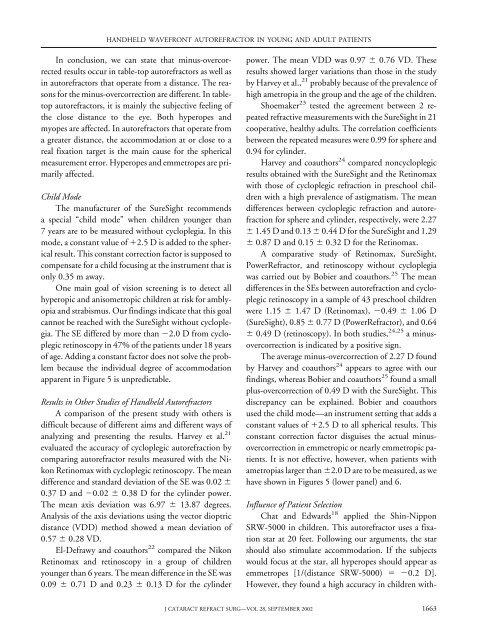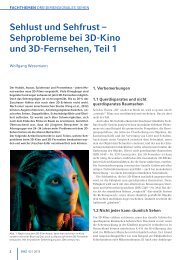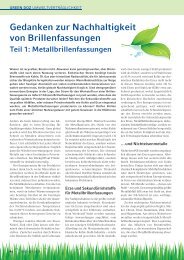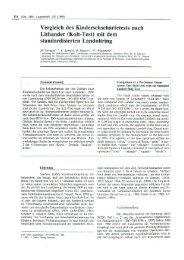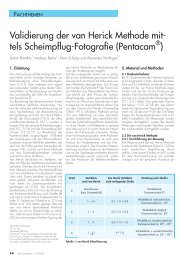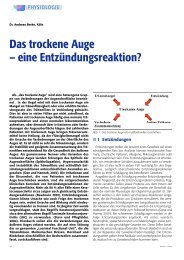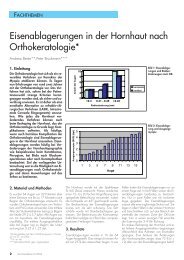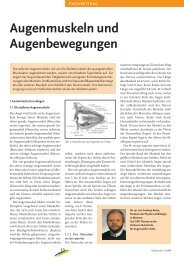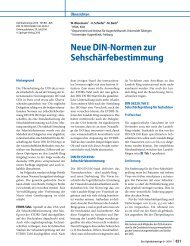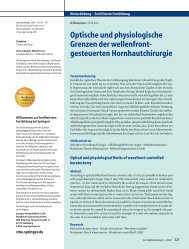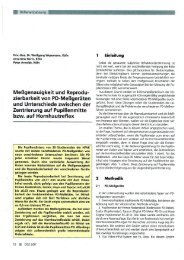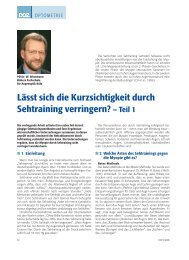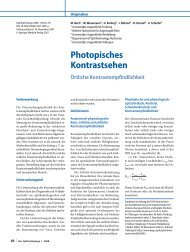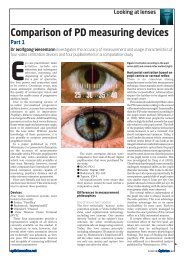Clinical evaluation of refraction using a handheld wavefront ...
Clinical evaluation of refraction using a handheld wavefront ...
Clinical evaluation of refraction using a handheld wavefront ...
Create successful ePaper yourself
Turn your PDF publications into a flip-book with our unique Google optimized e-Paper software.
HANDHELD WAVEFRONT AUTOREFRACTOR IN YOUNG AND ADULT PATIENTS<br />
In conclusion, we can state that minus-overcorrected<br />
results occur in table-top autorefractors as well as<br />
in autorefractors that operate from a distance. The reasons<br />
for the minus-overcorrection are different. In tabletop<br />
autorefractors, it is mainly the subjective feeling <strong>of</strong><br />
the close distance to the eye. Both hyperopes and<br />
myopes are affected. In autorefractors that operate from<br />
a greater distance, the accommodation at or close to a<br />
real fixation target is the main cause for the spherical<br />
measurement error. Hyperopes and emmetropes are primarily<br />
affected.<br />
Child Mode<br />
The manufacturer <strong>of</strong> the SureSight recommends<br />
a special “child mode” when children younger than<br />
7 years are to be measured without cycloplegia. In this<br />
mode, a constant value <strong>of</strong> 2.5 D is added to the spherical<br />
result. This constant correction factor is supposed to<br />
compensate for a child foc<strong>using</strong> at the instrument that is<br />
only 0.35 m away.<br />
One main goal <strong>of</strong> vision screening is to detect all<br />
hyperopic and anisometropic children at risk for amblyopia<br />
and strabismus. Our findings indicate that this goal<br />
cannot be reached with the SureSight without cycloplegia.<br />
The SE differed by more than 2.0 D from cycloplegic<br />
retinoscopy in 47% <strong>of</strong> the patients under 18 years<br />
<strong>of</strong> age. Adding a constant factor does not solve the problem<br />
because the individual degree <strong>of</strong> accommodation<br />
apparent in Figure 5 is unpredictable.<br />
Results in Other Studies <strong>of</strong> Handheld Autorefractors<br />
A comparison <strong>of</strong> the present study with others is<br />
difficult because <strong>of</strong> different aims and different ways <strong>of</strong><br />
analyzing and presenting the results. Harvey et al. 21<br />
evaluated the accuracy <strong>of</strong> cycloplegic auto<strong>refraction</strong> by<br />
comparing autorefractor results measured with the Nikon<br />
Retinomax with cycloplegic retinoscopy. The mean<br />
difference and standard deviation <strong>of</strong> the SE was 0.02 <br />
0.37 D and 0.02 0.38 D for the cylinder power.<br />
The mean axis deviation was 6.97 13.87 degrees.<br />
Analysis <strong>of</strong> the axis deviations <strong>using</strong> the vector dioptric<br />
distance (VDD) method showed a mean deviation <strong>of</strong><br />
0.57 0.28 VD.<br />
El-Defrawy and coauthors 22 compared the Nikon<br />
Retinomax and retinoscopy in a group <strong>of</strong> children<br />
younger than 6 years. The mean difference in the SE was<br />
0.09 0.71 D and 0.23 0.13 D for the cylinder<br />
power. The mean VDD was 0.97 0.76 VD. These<br />
results showed larger variations than those in the study<br />
by Harvey et al., 21 probably because <strong>of</strong> the prevalence <strong>of</strong><br />
high ametropia in the group and the age <strong>of</strong> the children.<br />
Shoemaker 23 tested the agreement between 2 repeated<br />
refractive measurements with the SureSight in 21<br />
cooperative, healthy adults. The correlation coefficients<br />
between the repeated measures were 0.99 for sphere and<br />
0.94 for cylinder.<br />
Harvey and coauthors 24 compared noncycloplegic<br />
results obtained with the SureSight and the Retinomax<br />
with those <strong>of</strong> cycloplegic <strong>refraction</strong> in preschool children<br />
with a high prevalence <strong>of</strong> astigmatism. The mean<br />
differences between cycloplegic <strong>refraction</strong> and auto<strong>refraction</strong><br />
for sphere and cylinder, respectively, were 2.27<br />
1.45 D and 0.13 0.44 D for the SureSight and 1.29<br />
0.87 D and 0.15 0.32 D for the Retinomax.<br />
A comparative study <strong>of</strong> Retinomax, SureSight,<br />
PowerRefractor, and retinoscopy without cycloplegia<br />
was carried out by Bobier and coauthors. 25 The mean<br />
differences in the SEs between auto<strong>refraction</strong> and cycloplegic<br />
retinoscopy in a sample <strong>of</strong> 43 preschool children<br />
were 1.15 1.47 D (Retinomax), 0.49 1.06 D<br />
(SureSight), 0.85 0.77 D (PowerRefractor), and 0.64<br />
0.49 D (retinoscopy). In both studies, 24,25 a minusovercorrection<br />
is indicated by a positive sign.<br />
The average minus-overcorrection <strong>of</strong> 2.27 D found<br />
by Harvey and coauthors 24 appears to agree with our<br />
findings, whereas Bobier and coauthors 25 found a small<br />
plus-overcorrection <strong>of</strong> 0.49 D with the SureSight. This<br />
discrepancy can be explained. Bobier and coauthors<br />
used the child mode—an instrument setting that adds a<br />
constant values <strong>of</strong> 2.5 D to all spherical results. This<br />
constant correction factor disguises the actual minusovercorrection<br />
in emmetropic or nearly emmetropic patients.<br />
It is not effective, however, when patients with<br />
ametropias larger than 2.0 D are to be measured, as we<br />
have shown in Figures 5 (lower panel) and 6.<br />
Influence <strong>of</strong> Patient Selection<br />
Chat and Edwards 18 applied the Shin-Nippon<br />
SRW-5000 in children. This autorefractor uses a fixation<br />
star at 20 feet. Following our arguments, the star<br />
should also stimulate accommodation. If the subjects<br />
would focus at the star, all hyperopes should appear as<br />
emmetropes [1/(distance SRW-5000) 0.2 D].<br />
However, they found a high accuracy in children with-<br />
J CATARACT REFRACT SURG—VOL 28, SEPTEMBER 2002 1663


